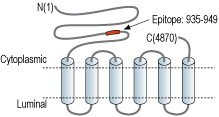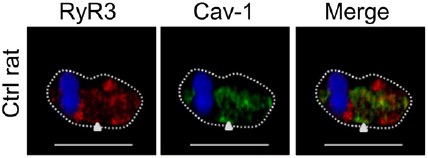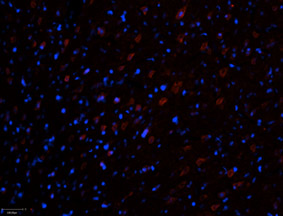Overview
- Peptide CHIAHVNPAAEEDLK, corresponding to amino acid residues 935-949 of human RyR3 (Accession Q15413). Intracellular, N-terminus.

 Western blot analysis of rat brain membranes:1. Anti-Ryanodine Receptor 3 Antibody (#ARR-003), (1:200).
Western blot analysis of rat brain membranes:1. Anti-Ryanodine Receptor 3 Antibody (#ARR-003), (1:200).
2. Anti-Ryanodine Receptor 3 Antibody, preincubated with Ryanodine Receptor 3 Blocking Peptide (#BLP-RR003).
- Human ESC NPs (1:100) (Forostyak, O. et al. (2013) Stem Cells Dev. 22, 1506.).
- Chakrabarti, R. and Chakrabarti, R. (2006) J. Cell. Biochem. 99, 1503.
- Eisner, D.A. et al. (2005) Exp. Physiol. 90, 3.
- Hamilton, S.L. (2005) Cell Calcium 38, 253
- Fill, M. and Copello, J.A. (2002) Physiol. Rev. 82, 893.
It is well established that cytosolic calcium (Ca2+) acts as a key second messenger in many intracellular pathways including synaptic transmission, muscle contraction, hormonal secretion, cell growth and proliferation.1,2 The primary intracellular Ca2+ storage/release organelle in most cells is the endoplasmic reticulum (ER) or the sarcoplasmic reticulum (SR) in striated muscle cells.
The ER and SR contain two Ca2+ release channel families, the inositol trisphosphate receptors (IP3Rs) and the ryanodine receptors (RyRs).3
The ryanodine receptor family consists of three different isoforms: the skeletal muscle isoform, ryanodine receptor type 1 (RyR1); the cardiac muscle isoform, ryanodine receptor type 2 (RyR2) and the brain isoform, ryanodine receptor type 3 (RyR3).3
The ryanodine receptors are homotetrameric proteins, which upon assembly create a Ca2+ conducting channel. They play a key role in the mechanism of excitation-contraction coupling in striated muscle. Binding of ryanodine (a poisonous alkaloid found in the South American plant Ryania speciosa) to the ryanodine receptor causes two major changes in the channel: a reduction in single-channel conductance and a marked increase in the open state probability, leading to an overall increase/decrease in the Ca2+ release capability of the channel.
RyR3 is the most widely expressed RyR channel which is predominantly expressed in smooth muscle tissues and certain regions of the brain.
Application key:
Species reactivity key:
Anti-Ryanodine Receptor 3 Antibody (#ARR-003) is a highly specific antibody directed against an epitope of human RyR3. The antibody can be used in western blot, immunocytochemistry, and immunohistochemistry applications. It has been designed to recognize RyR3 from human, rat, and mouse samples.

Expression of RyR3 in rat PASMCs.Immunocytochemical staining of rat pulmonary arterial smooth muscle cells (PASMCs) using Anti-Ryanodine Receptor 3 Antibody (#ARR-003), (red). Cav-1 is stained in green.Adapted from Gilbert, G. et al. (2016) Am. J. Physiol. 310, L1078. with permission of The American Physiological Society.
Applications
Citations
- Mouse smooth muscle cell lysate (1:200).
Lee, M.Y. et al. (2015) PLoS ONE 10, e0133751.
- Rat adipose-derived stromal cells and rat bone marrow stromal cells.
Forostyak, O. et al. (2016) Stem Cell Res. 16, 622. - Human ESC NPs (1:100).
Forostyak, O. et al. (2013) Stem Cells Dev. 22, 1506.
- Yoshida, S. et al. (2010) Neurosci. Res. 68, 322.

